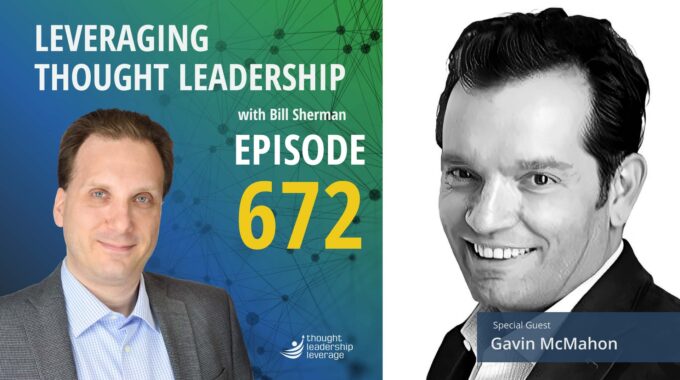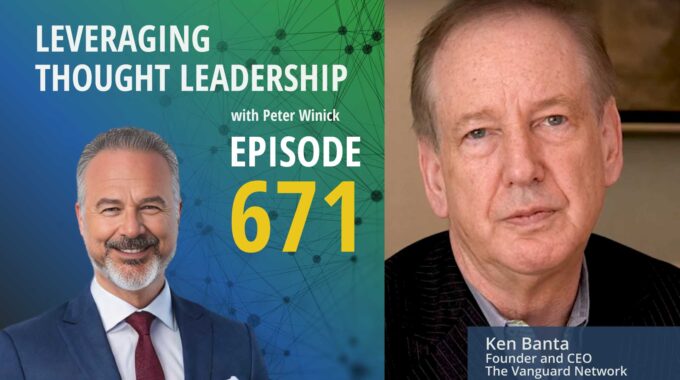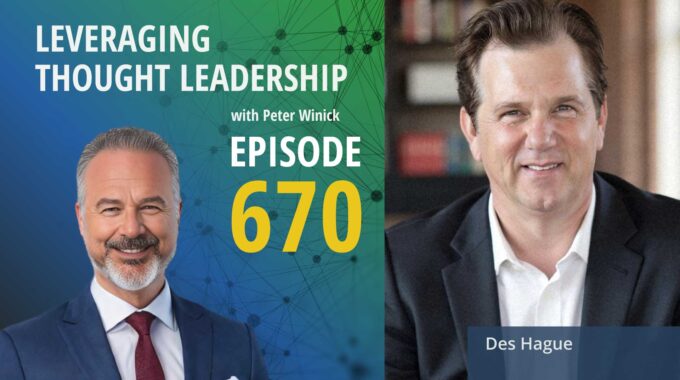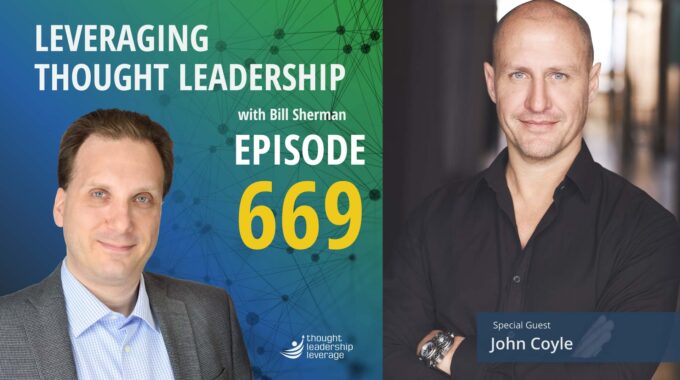How Storytelling Turns Smart Thinking into Real Influence Great ideas don’t win — great stories…
Creating Actionable Thought Leadership Speakership | Lee Colan | 215
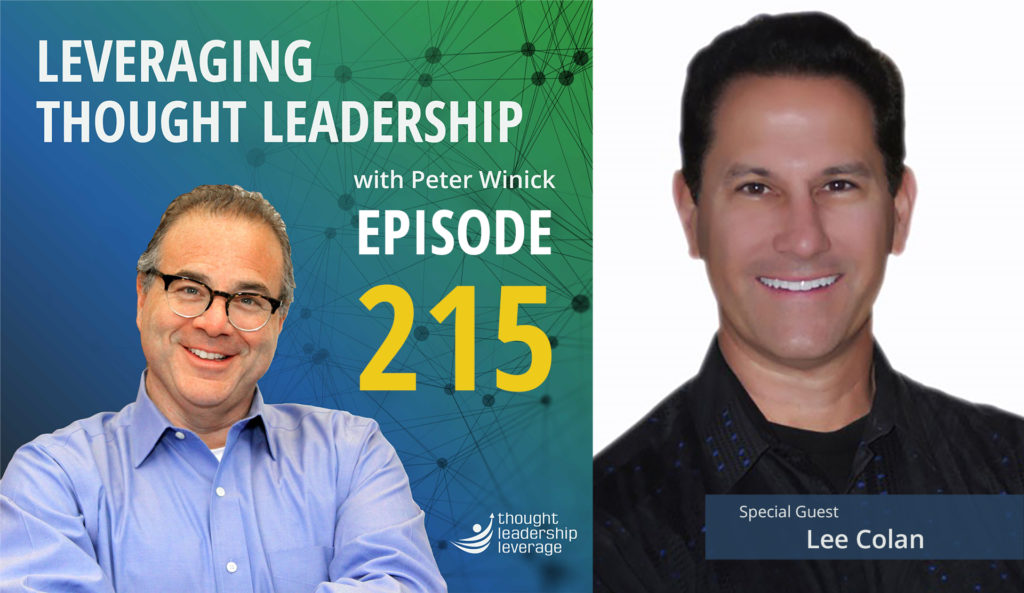
How A Thought Leadership Speakership Model Can Give Your Speech Staying Power
An interview with Lee Colan about thought leadership speakership, creating a flexible, elegant model for your thought leadership, and how to create actionable insights for your audience.
Today’s guest is Lee Colan, a leadership adviser, consultant, best-selling author of multiple articles, co-founder of the L Group, and author of 14 leadership books including his new release, The Power of Positive Coaching. He’s here to talk to us about thought leadership speakership, creating content models, and providing actionable insights that move your audience to act – from the minute you leave the stage.
Three Key Takeaways:
- Why it’s important to make your audience feel like they’re equipped with practical tools and actionable, impactful insights.
- Why it’s important that your thought leadership speakership be based on a model that shapes engagement, execution, culture, and attitude.
- How to build an elegant model for your thought leadership speakership that gives your audience simple, actionable insights to help them – from the minute the speech is over!
If you enjoyed this podcast on actionable thought leadership speakership, check out Thought Leader on the Go!
Transcript:
Peter And welcome, welcome, welcome, this is Peter Winick. I’m the founder and CEO of Thought Leadership Leverage and you’re joining us on the podcast today, which is leveraging thought leadership. Today my guest is Lee Colan, and Lee is the co-founder of the L Group, which is a Dallas based consulting firm that’s been equipping and encouraging leaders since nineteen ninety nine. He’s an organizational psychologist with a rare combination of skills as a business consultant, thought leader, prolific author and engaging speaker. And under the prolific author bucket, Lee has coauthored 15 leadership books, including two bestsellers. He has been a finalist on The Thinkers, 50 nominees for a top management thinker globally. He has worked with some very amazing clients and to including American Airlines, Booz Allen, Novartis and on and on. In the interest of time, I’m going to cut short the file and get right down to it. So. Well, welcome aboard. Lee, thanks for coming on board.
Lee Colan Welcome. Thank you, Peter. Appreciate you having me there. Thank you for – that I hear about myself.
Peter I would say that the problem with bringing on folks like you, that I’ve been doing this for quite some time and really bring a lot of books and all that is it takes a lot of time to introduce yourself. Cut that short. So let’s just sort of dive right in.
Lee Colan Sure.
Peter So, sure, you check many of the boxes of the folks that we talked to. Right. So speaker, author, consultant, etc.. So let’s just sort of start with maybe paint us an overall picture of how those things work together to meet your objectives, because there’s a lot of stuff you could be doing. How do you how do you make the decisions to do what you do at the level that you do it?
Lee Colan Sure. So I’m really a trained consultant at heart. I was I’ve worked with Booz Allen and Wayman Mercer before I started this business. And even as an internal executive, an O.D. guy in the corporate world, I was kind of an internal consultant. So. So we really are a consulting firm. It’s at the core. So if you could picture kind of a circle with three kind of legs to it. So we start with our consulting around culture and engagement and execution. We do a lot of executive coaching. So we try to take those solutions. We put in play with our clients and then codify them so that other people that are not our consulting clients can get exposure to them. So our core is are we generate most of our revenue from our consulting and coaching. And then those those tools that we try to develop to codify those solutions really become books. And so we have 15 of those. And then obviously each book has supporting products like training kits and video and all that kind of stuff. And so that becomes the second leg to our business, the way of consulting. And then we have resources that we create training resources and all that kind of stuff stemming from the books. And I’m fortunate enough people enough to buy the books. We do a fair amount of speaking and training. So those are the three words to our business tool, consulting resources, and then speaking training. It’s not a very balanced tool. I’ll be honest with you. Most of our generate revenue still generate from the consulting side, but we’re working now to try to make sure we kind of monetize a little bit better. Our intellectual capital that we have our individual property around the books and stuff.
Peter So, yeah, I actually I want to go half a step back to something that you started with. Where because I think it’s an interesting point is at your roots, you define yourself as a consulting company. Right. So some people and I don’t think there’s one right way or one way some people start to speak or some people start as coaches, advisers, consultants. But it sounds like, you know, you sort of broke into the consulting world being on the other side. Right. Being a consultant at some of the big, big houses. And when you start as a consultant, you know, you realize that your clients are hiring you to solve difficult problems. And it’s less about entertaining than around outcomes. So how does a sort of those routes of consulting play out across all the different things that you do? Because I think that’s a great point that you make.
Lee Colan Yeah, you know, because we’re a very kind of tool-based how-to kind of consulting firm. And I think, you know, it’s great if you have some splash and motivation for your audience, if you end up doing speaking. But I believe if people need to be kind of inspired and equipped. So, you know, for example, at the beginning of our ah speaking career is to just go out and be kind of the content expert, you know, and frankly, it wasn’t all that interesting to listen to. But I had these like model which resonated with people. That was great. And then I realized that, you know, I’ve got to flip it. And like, I’ve got to be entertaining and all that kind of stuff and then drip in, you know, pop in my learning points along the way. So I’ve kind of evolved in that regard also because people do want to be inspired and motivated. But to really be, I think, sustainable as a on the speaking side. People really want to feel like they’re equipped with something that got some practical tools, something that’s actionable that they could take away from that emotional high for a moment and then create some impacts that people that are hiring speakers at the larger organizations want to know that they’re getting some return, not just this guy that, you know, climb the, you know, the Himalayas or something. You know, that’s great. And those are cool. I’ll never be that person. But they still want even if it’s someone like me, they want to be inspired and encouraged, but then feel like, okay, now there’s something that we could actually change behavior for our audience. So that’s kind of the balance we. So I think particularly after 2008, eight people are much more looking for what’s the hour away from us speaking. How do I kind of help it move the organization forward and help equip my audience? So.
Peter I think that’s great. Well, I think there are there is a time and a place for the entertaining speaker or the motivational speaker, rather. You know, someone attended amazing life experience, Olympic gold medalist or whatever. And that’s fine. Give me an example, though, of equipping. Right. So oftentimes what happens is, you know, you’re sitting there listening to a speaker. Your eyes go wide, you’re jotting down notes, you engage. They’re interesting. They’re fascinating, whatever. And exactly to your point, if that person didn’t equip me with a tool was something that I can do that’s actionable. When I get back to my desk, you know, the following day, then it just gets filed in the. Well, that was interesting category and not impactful. So how do you do you give some examples of how you connect the dots there? Because I think that’s people struggle with that.
Lee Colan You know, sometimes I say we really don’t. I’m not really telling you anything new. But we try to pack it in ways that kind of resonate with people. It might be as simple as a metaphor or a little a tool. So, for example, we’ll talk about accountability. And everyone wants the accountability. I was like, okay, what’s easy button? You get your team to be more accountable. So we were given a simple tool, the three W tool. So it’s the rich. All right, what, who and when. So whenever you leave a meeting, whenever you leave an interaction, you confront with people what’s going to happen, who’s gonna be accountable and by when? And then and the next meeting, you follow up with that. OK. This is what you committed to last night. So something as simple as like the three W tool gives you like, oh, gosh, I can like write that down on my palm, my hand. And I’ve got something that can help elevate my accountability with my team moving forward. So not rocket science. Right. And I always tell people there’s no rocket science what we talk about. But there is science. We understand, my Beckman’s that organizations like organizational psychology. So we understand how people work, how organizations work. So we try to use those dynamics to come up with a simple, actionable tools like that. And a million others like even just like on the on the kind of like how do you manage your own emotions side? We always talk about the you know, the five by five by five. We like it. You know, if something’s not going to Internet impact to you or really affect you five years from now, don’t spend more than five minutes thinking about it. Right. So just simple little things that kind of can stick. We call a mental anxious thing to kind of stick in your mind, whether it’s in a handout or actual physical tool. But more important to just stick with that. Oh, OK. Next time I find out that the to my coworkers, let me just step back and think about think about that five by five.
Peter I think the challenge that most people have is when they’re exposed to a new concept or a new idea. You know, like you said, it doesn’t have to be rocket science per se. But if you don’t give them the tools, you know, there’s a fear of, am I going to do this right? Am I going to look silly? Do I really get it? Etc.. So it’s easier to not do anything than to take that risk. So by giving them a simple framework or language or, you know, here’s how to do that. I think it really accelerates the probability that you’re actually gonna take some level of action and internalize that.
Lee Colan So let me elevate that for a minute. I’ll give you a couple of very tactical tools. My natural gift is to just see complex things and come up with something really simple. Probably just because I’m a pretty simple minded guy. And so, for example, we have we have a model of adherence and we call it a model execution. We call it adherence, the adherence equation. So it’s as simple as to be able to stick with your plans. You have to sharpen your focus, build your competence and ignite your passion. So it’s focused on its competence likes passion. It’s multiplicative equation. We kind of play it out. You can see how the numbers work equals your ability to stick with your plans. So. So when we speak on that, many times, organizations will have that equation plastered all over the wall. It becomes a framework to help their organization execute better. So anytime they do a new initiative, or any company try to elevate a leader skills, it’s like, okay, how does that help you sharpen your focus? What do you say? Yes to what you say no to. It’s like the what the how on the watch focuses your what competencies you have passions you. Why so? So we have these just models that kind of resonate with people because they struggle with things like engagement, execution, culture, attitude. And we just provide kind of a simple metal model that they could look at and go, oh no, I can manage my attitude. That’s something fairly esoteric. Now I can execute better. That’s something pretty challenging. So those simple models help people make sense of the world or expose be completely comprehensive and perfect. No, but it’s enough that enables managers and leaders to kind of feel like empowered, like, oh, I can get my hands around that head, around that concept now and take action. So that’s our goal.
Peter So in the work that I do and my organization does with clients there, there’s just there’s a continuum. There’s a spectrum right there. A lot of folks that we work with at. More of an academic bent that have models that have been validated to the eleventh decimal. They’ve done the Qs where they’ve done all the things they need to do right. Then there are others that come more from the applied side. Maybe they’re consultants or they’ve been on the business side of the house and they don’t really have a model, but they kind of have to have a model and they talk about things. And, you know, you believe them because it’s how it’s worked for them. Can you can you talk about just how critically important it is to have a model of some sort? So that you can articulate and frame how you see people, you know, fixing a problem or dealing with, you know, whether it’s accountability or resilience or whatever the case is, because I think, you know, the curse of the expert is sometimes it’s so clear to them in their minds. But without a model, it gets you know, it gets lost in translation so that, you know, getting back on with the patient, you talk about just the critical importance of having a model.
Lee Colan I’ll underline I’ll just say it this way. It’s very important to do it. So, it is because it’s not you just the mark, let alone like for example, we have you can have a model of “how do you design a culture”, right. So that you can find someone to be consulted or create a wall of 20 feet by 20 feet with some crazy model. So it’s not just a model. It’s a model that empowers people that things like, OK, I could get my head around that it doesn’t have fifty-seven components to it. So, there’s it has to have some like simple elegance to it like wow. That really captures it. And it’s simple. So, I do see people develop models sometimes and you can see if there come from an academic bent, it’s fairly complex and then it is comprehensive. I get it. But we’re dealing with people in the business world. We live in this information rich time for war, right? Leaders to try to like juggle a million things so we can’t have every single do what’s in. Right. So what kind of 80/20 rule? What is your model like? Kind of at least addresses most of the complexity of the issue you’re trying to address, whether it’s accountability or culture or execution, whatever might be engagement. And then it’s simple enough to say, oh, I get it. Like when people look at our models, they’re all like, oh, Lee, that’s so intuitive. I get that. And I’m thinking, that’s exactly what I wanted. I don’t want you to feel like, oh, I couldn’t get my head around that. Right. So I wanted to feel intuitive. And I want us to to be able to articulate things in what I call simple truths, because if you can get to that fundamental truth of something, it is simple. Truth are timely and also timeless. Yes. So we try to get to the human dynamic. What underlies people’s ability or inability to execute, to develop a culture correctly. And then if we can articulate that, when people look at it go, oh, that makes sense. And it’s just face value. It doesn’t have to be based on incredible amounts of research. If there’s face validity to it and it’s simple, they get their head around it. Now it’s like now I want to apply that, but I don’t need to have we’ll be looking at this model and say, oh, if someone says this and I need to do that if something like a coaching model, but also that I’ve seen many coaching models that are very strict, that if Peter says this, you need to say that I’m like, well, that’s handy. But I I can’t have like a flip chart in front of me every time I need to talk to someone. So we try to boil it down into like simple things. So I think models are great, but not in and of themselves. They need to be simple and empowering and capture most of the truth. But you don’t feel morally obligated to capture every single thing. Is that it just getting unwieldy?
Peter So let’s talk about that, because I think part of the I call an excuse for lack of a better term that people make for not having a model is not. No, no. But this can’t be in a model because I’ve been doing this for 20 years or 30 years or whatever. And you know, I just know and I’m not trying to diminish the value of someone’s deep expertise. But what is a logical expectation that you as a thought leader is a creative or a model can have for the model in terms of which it’s not something that you use in every situation, the highest peaks, et cetera.
Lee Colan I think if you want to be known as an expert, you have to have a point of view and you have to have something that that makes sense for most of the people. I understand the nuances and all the idiosyncrasies of any organization, any person you might be dealing with. But I think to me, it shows a higher level of thinking to say of all my experiences of dealing with the thousands of people or hundreds of organizations. These are the things I see in common. To me, it elevates your status as an expert. And then also enables you to be on a scale that maybe other people can. You have other people on your team that could kind of implement that model. Maybe it turns into a training kit or some other assessment that you could be selling and other people can be using. So, if you want to build a scale your business and be perceived as a real expert, I think you have to have some type of repeatable model. Yep. And I appreciate the fact that their idiosyncrasies I get all that. But, you know, I think just on a treadmill, if you don’t if you are somehow a model that people can get.
Peter Well, you touched on a scale issue. So I want to go back to that. Right. So you know, one way to build a consulting firm, not the ideal way, is you hire a bunch of smart consultants and say, hey, you guys are good. Figure it out. Right. Like, that’s one way that many folks operate. Another way to do it is to say, actually, we’re a consulting firm. Here are our models and frameworks. They’re not, as you know, to your point earlier, scripted where you’re not you’re not tapping into. You’re not a. Maintaining the need for expertise. Are you saying when we solve a problem, this is the way these are the lenses that we look through? Or this is the model that we use for accountability or feedback or whatever, and you get a level of consistency. Not at the McDonald’s. You know, every burger has got three pickles at a 12 degree angle, but some little consistency to scale and serve your clients better. Right. Because otherwise it’s oh, if I got lead today and Sally tomorrow and Fred the next day as my consultant, it is all over the place. Can you tell me how that’s helped you grow your business?
Lee Colan And I think it’s great. It comes from the right place them with a good heart. People there consult, oftentimes want to serve. So they want to say, hey, you know, we’ll just meet your need. We’ll customize everything to you. And that’s all great. But I have found great power and saying this is the model. And here’s not even this is the model. Here’s how we work. And so I think there’s another level of this is saying we’ve sown not only we have a model, but this is the way to implement it. So we find a lot of console’s going, oh, here’s our model, like, oh, you do this, you do this and we’ll tweak this. And it’s great to customize to some extent. But I tend to say, here’s how we work. We have a proven methodology. I believe most clients are buying confidence, yet they want to know that these guys have been there, done that before, and I’m willing to go on the journey with them step by step. And I think a lot of people out of fear don’t want to do that. I might lose them. They might think I’m frigid. But I really think it’s not just the model, but it’s the methodology of how you implement. It needs to be like, here’s how here’s how we work. And again, it elevates your perception as the expert. And if you don’t really feel confident that these are the these are the steps, I’d say you probably need to get to a point of feeling like what is it going to take for us to say that we know this is what’s the proven way? This is all about we do step one, step two, step three. And then you and we find him with most consults and most people in general fear there’s like, oh, I know. And I think you’ve got to be bold a little bit to say this is what we’re all about. And if you want to work with us, this is the way we work without being arrogant. But I think there’s people are buying that confidence.
Peter Well, there’s a fine line between arrogance and confidence. But I think you’re right that, you know, the clients are you know, why are they coming to you? They’re not coming to you to have an intellectual debate around methodologies and models. And, you know, my business is different than everything else. They’re really coming to you and paying you a premium fee to solve a problem that they couldn’t solve on their own because they could solve it on their own. You wouldn’t be there. Right. So I think there’s a point where you need to push back on them a little bit. So, listen, I understand that this is a mission critical problem for you and it could be a game changer. Once we get this right. But you need to trust me a little bit as I’ve been doing this for X number of years. This is the framework, a model we use. This is why we use it. This is how it works. And at the end of this engagement, whatever that looks like, we’re gonna get you the relief that you need. And I think that what I’ve seen consultants sort of compromise too much. I mean, what you want to serve your clients, but relative to the models and such, it’s a lose. You’re working twice as hard, to have half the chance of solving the problem for the client.
Lee Colan Right. And we again, we find it’s based in fear.
Peter It’s definitely based on fear. So, if we start to wind up this way quite quickly, actually. Any final thoughts, nuggets, stuff for folks to chew on that are in, you know, maybe don’t have the 15 books under their belt and maybe not doing it as long as you have over 20 years?
Lee Colan And again, I don’t think books are the answer. We just happened to do that. I would just say I always have a point of view. Right. Have a have a simple, actionable model that supports that point of view and be bold about how you’re willing to communicate that. And so that’s it really and I think you have to have a clear point of view that’s actionable for people. And if you feel passionate about it, you shouldn’t hold back about communicating with that level of passion, whether it’s in a blog post or when you’re speaking or in front of a client, if you’re confident that you need to be all expressing confidence, that’s all.
Peter That’s fantastic. Well, I appreciate you spending some time with us today and sharing all that. You shared a lot of good stuff on models and frameworks and all that sort of fun stuff. So thank you so much. I appreciate your time today. Great.
Lee Colan Thank you, Peter.


